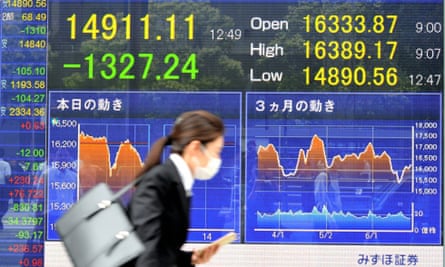In 2009, when the world was still absorbing the shock of the previous year’s financial crisis, a book called The Spirit Level was published. Written by a couple of social epidemiologists, it argued that a whole raft of data conclusively showed that societies with greater inequality also had a range of more pronounced social problems, including higher rates of violence, murder, drug abuse, imprisonment, obesity and teenage pregnancies.
Given that naked profit motive had just taken the world to the brink of economic collapse, it was a good moment to take stock and reflect on where rising inequality was leading us. For the previous 30 years a broad consensus had operated in politics, particularly in the US and Britain, that as long as those at the bottom were being lifted by the rising tide of wealth, then it didn’t much matter that those at the top were rising much faster.
As Peter Mandelson famously said to a gathering of Silicon Valley executives in 1998, when he was Labour’s secretary of state for trade and industry: “We are intensely relaxed about people getting filthy rich.” What’s usually knocked off that statement is Mandelson’s proviso: “As long as they pay their taxes.”
That was the big breakthrough in New Labour’s politics. Instead of demonising the rich or sending them abroad with punitive taxes, they realised it was better to encourage them and raise revenue that could be spent on the underprivileged and other needy causes. And in many respects it worked. The economy expanded, more money was spent on education, the NHS and social benefits, and who cared if in the process a few more billionaires were created or the bonus culture got a little excessive?
But then the crash came, it turned out that the boom and bust years were not over, and we found ourselves as ordinary taxpayers in the unjust position of bailing out the banks that had been guilty of the greatest excesses of greed and social irresponsibility. As a result austerity followed and those who suffered most from its effects were the poorest members of society. Meanwhile the bonus culture continued, the banking industry has changed little (in America, the Trump administration is now loosening the limited financial regulations put in place after the crash), and, despite a slight decline, income inequality remains strikingly high in the UK – FTSE CEOs earn on average 386 times more than workers on the national living wage, and the top 20% of the country earn 15 times more than the bottom 20%, before tax and benefits, and about four times after that readjustment.
Now Richard Wilkinson and Kate Pickett, the authors of The Spirit Level, have returned with a new book, The Inner Level: How More Equal Societies Reduce Stress, Restore Sanity and Improve Everyone’s Wellbeing. I meet the pair, who are a couple, at a bar in St Pancras station, London, where we talked about their work while they waited for a train back north – Wilkinson is emeritus professor of social epidemiology at the University of Nottingham, and Pickett is professor of epidemiology at the University of York.
Wilkinson is in his mid-70s, but aside for a slight hearing problem and a pair of impressively wintry eyebrows, he is a picture of youthful energy, not to mention scathing opinions. If anything it’s Pickett, 22 years his junior, who is the moderating voice.
The new book, as the subtitle suggests, focuses on the psychological or mental costs of inequality, which, they argue, are many and varied. The basic premise is that inequality creates greater social competition and divisions, which in turn foster increased social anxiety and higher stress, and thus greater incidence of mental illness, dissatisfaction and resentment. And that leads to coping strategies – drugs, alcohol, and addictive behaviours like shopping and gambling – which themselves generate further stress and anxiety.
It’s a bleak portrait, but one that Wilkinson and Pickett insist could be quickly and effectively improved.
The Spirit Level sold more than 150,000 copies and was translated into numerous languages around the world. But I wondered if – given that the situation hasn’t greatly changed – they felt governments, particularly the British government, had taken notice.
Wilkinson mentions being consulted by Ed Miliband when he was Labour leader, and that he’d given a seminar to John McDonnell’s advisory group – though of course neither was part of the government at the time. He says there have also been a couple of meetings with the Lib Dems. He doesn’t make it sound like the revolution is imminent.
Pickett takes the opportunity to interrupt her partner.
“To answer more systematically,” she says, perhaps with the faintest of admonishments, “we’ve been consulted at international, national and local level. We’ve done a fair amount with various UN organisations, we’ve done EU things. I’m on the commission for sustainable equality.”
Christine Lagarde, head of the IMF, made a statement on equality that they recognised as coming directly from their book. And President Obama also said some things that, as Wilkinson puts it, “sounded a bit like it might have come from us”. But perhaps the biggest impact was among fellow academics, who have since started to look at the effects of inequality in many other disciplines.
There were also critics – dismissed by Wilkinson and Pickett as “ideological” – who questioned either the validity of their statistics or the conclusions they drew from them. What struck me, reading the book, was that if the homicide rate was a major sign of inequality then it was noticeable that since 1980, the year that inequality really started to grow in the US after 50 years of flatlining, murders also began to fall. There is now a lower murder rate in America than there was in 1950. What accounted for that apparent anomaly?
“It means there must be other things involved,” says Wilkinson confidently. “But we can say that if those same changes, whatever they are, had happened without the increase in inequality, homicides would have fallen even more.”
This seems a remarkably bold prediction, but then Wilkinson has been working in the area of inequality for decades, and he is as convinced of his case as only someone who has spent so long studying one subject could be.

There certainly seems little doubt that reports of anxiety, particularly among young people, are much more widespread now than have been in living memory. A recent US study found that 20% of Americans reported being highly stressed, and an older study suggested that the average American child in the 1980s “reported more anxiety than child psychiatric patients in the 1950s”. Yet the 1980s, as a King’s College London study has shown, was, by comparison to recent years, much less stressful for teenagers in Britain.
“Given that economic growth has brought us unprecedented luxury and comfort,” Wilkinson and Pickett write, “it seems paradoxical that levels of anxiety have tended to increase rather than decrease over time.”
To many lay observers, the answer is that today’s young people, the so-called “snowflake” generation, are less hardy than their predecessors, less willing to accept difficulties and more likely to voice anxiety or distress about adverse circumstances they may encounter.
Wilkinson and Pickett posit a very different explanation. They believe that the growing anxiety stems in larger part from increasing social pressures brought about by material inequalities – in effect greater status anxiety. A recent meta-analysis of studies published in the Lancet Psychiatry concluded that rates of mental illness were higher in societies with larger income differences. The UK and the US are at the top of the graph on both mental illness and income inequality.
However, New Zealand has three times as much mental illness as Italy, and the same levels of income inequality, and France has double the rates of mental illness as its neighbour Spain, and yet its income inequality is roughly the same. Clearly there are many factors at play, but I wondered if material wellbeing itself might be the cause of anxiety, which is to say that the further we get from existential struggle, the more anxiety we feel about other challenges and stresses.
“If that were true,” says Wilkinson, “anxiety would be related to GNP per head, which it is not. It also suggests not merely a free-floating amount of anxiety which then becomes attached to something, but that the decline of a main source of anxiety – subsistence – would actually increase overall anxiety. Is that really plausible? We have not come across it before.”
He notes that the Italian anomaly is usually attributed to the close family relationships in Italy. In any case, he maintains that it’s the general consistency of the data showing the relationship between inequality and mental health, rather than the anomalies, that is most notable. And it’s Wilkinson and Pickett’s contention that we are mentally in a dysfunctional relationship with hierarchy, constantly seeking to establish a higher foothold on the social ladder, and it’s a struggle that negatively affects all classes and income brackets.
Anyone who has looked at Instagram recently would be hard pressed to deny the degree of social anxiety on display. Never have we been so adept at flaunting both our wealth and our insecurities.
So let’s agree, for the sake of argument, that inequalities breed anxieties which in turn damage mental health. But could this be a price worth paying for society at large?
There’s a scene in The Third Man in which Orson Welles compares the 30 years of brutality and bloodshed under the Borgias, which produced “Michelangelo, Leonardo da Vinci and the Renaissance”, with the 500 hundred years of peace and democracy of the Swiss, which gave us the “cuckoo clock”. Is there a sense that more equal societies are less creative, less dynamic?
“No, absolutely not,” says Pickett. “That argument is one of the arguments that people make to say perhaps we need a certain amount of inequality because it drives aspiration and innovation and creativity, but the evidence doesn’t support that. The evidence suggests that there are more patents [for inventions] awarded per head of population in more equal societies.”
“Marginally more,” cautions Wilkinson.
“Uneven societies waste a huge amount of talent. Lower social mobility, lower educational attainment, they’re not optimising capital development,” says Pickett.
The same principle applies to organisations too, she says. “There is evidence showing that companies with a bigger pay ratio are less efficient, less productive, produce less shareholder value, so they’re not driving the kind of benefits that the apologists for inequality suggest.”
Both more or less agree that the Soviet-led communist experiment doesn’t offer much by way of encouraging evidence for the benefits of equality, partly because of the poor data available but also because of the levels of oppression that maintained that equality. The models they tend to point to are Scandinavia and Japan, which are much less unequal than the UK and the US, and show significantly reduced signs of social tension, status anxiety and poor mental health, and a higher tendency towards trust and reciprocity or what’s known among sociologists as “social capital”.
The US political scientist Robert Putnam found that more ethnically and culturally diverse communities – particularly in America – were likely to possess less social capital. And with reduced trust and sense of reciprocity, people are less willing to contribute to others’ wellbeing. Could Japan’s and Scandinavia’s high level of social capital and lower levels of anxiety be attributed to their greater ethnic and cultural homogeneity?
“I’m not so sure Putnam’s right about that,” says Pickett. “If you think about Japan – which is perhaps the most homogenous of all those countries we’re looking at – they don’t achieve their equality through taxes and benefits [Japan has a lower income range rather than a higher tax range]. So I don’t think homogeneity is required for equality.”
In a sense, all politicians believe in equality, the equality of opportunity – or at least they all pay lip service to it. But reading Wilkinson and Pickett’s book, I get the impression that they would like to see more focus on the equality of outcome.
“Yes!” they both chorus.
“I think you can’t have one without the other,” says Pickett. “There is this consensus across the political spectrum that equality of opportunity is a good thing, but when you really start to unpick that, you can’t have that without greater equality of outcomes.”
Without addressing outcomes, they say, the opportunities will always be heavily loaded in favour of the privileged. This seems to me a reasonable point. The problem, of course, comes in rebalancing those outcomes. One way, Pickett suggests, might be a re-evaluation of how we reward different skill sets.
For example, at the moment numeracy and computer literacy are premium skills that often command high salaries. Whereas those with an ability to look after the old and infirm or an empathetic outlook required in social work are frequently much less highly valued by society and the market. However, as artificial intelligence makes increasing inroads into the computerised world, that imbalance could conceivably be smoothed out.
Wilkinson sees automation as a straightforward equalising measure.
“It’s about taking rises in productivity out in terms of leisure rather than increased income,” he says like a true social scientist.
But as Pickett acknowledges, increased leisure, like increased equality, will necessitate a huge cultural shift and require an ambitious approach to education of both adults and children alike. The scale of the undertaking is not something that comes across in their book, which is mostly concerned with highlighting current systemic problems.
Whatever one makes of Wilkinson and Pickett’s thesis, it seems obvious that high levels of inequality do diminish trust and belief in reciprocity. Just how much these effects account for mental ill-health or, indeed, how mental ill-health is defined and measured, are subjects worthy of informed debate. If nothing else, it surely warrants our attention that countries such as Germany, Sweden and Japan manage to thrive with much lower levels of inequality.
Yet leaving aside whether it’s desirable, there is no such thing as complete equality, and attempts to bring it about have inevitably led to the worst kinds of repression. Still, that’s not an argument for unconstrained inequality. Where, though, to start on narrowing the distance between rich and poor? If they could impose one piece of legislation tomorrow what would it be?
“I would want companies to have to put some of their profits each year into an employee-controlled trust which would then have voting rights on the board,” says Wilkinson.
“I’d go for a Finland-style educational system, completely comprehensive,” says Pickett.
The question of inequality is likely to play a bigger role in the next election than it has for more than a generation. It would be better for all of us if that debate was informed by robust statistical analysis rather than the emotive politics of envy. Any politician wishing to do so would be wise to read Wilkinson and Pickett’s books.
How inequality shapes children’s ‘natural’ ability from day one: an extract from The Inner Level
Rather than innate ability determining where people end up in a supposedly meritocratic hierarchy, the apparent abilities of children and their subsequent social status are instead heavily influenced by their family’s position in that hierarchy. Vast numbers of studies have now demonstrated the cognitive damage that living in poverty does to children. They also provide strong evidence that lower levels of ability among children in poorer families reflect the less stimulating and more stressful family circumstances that poverty produces. The cognitive deficits found in studies of children from poorer families show clearly that they are created, rather than being innate and unalterable givens.
A recent study in the United States used MRI scanners to scan children’s brains up to seven times each between the ages of five months and four years. Comparing children from high- , medium- and low-income families, it found that children in lower-income families had lower volumes of grey matter (containing neural cells, dendrites and synapses), which is essential for cognition, information processing and behavioural regulation. Although there were not clear ordered differences at five months, by four years of age the volume of grey matter was around 10% lower among children from less well-off families compared to the most well-off group. These differences were not accounted for by infant birth weight, early health, or by differences in head size at birth. Nor were the differences explained by maternal smoking, excessive drinking in pregnancy, birth complication, significant language or learning disorders and a number of other risk factors – children with risk factors such as these were excluded at the start of the study. Differences in brain volume between the income groups emerged and widened as children grew up and were exposed to their contrasting home environments for longer.
Other studies have also shown that the harmful effects of relative poverty on children’s cognitive development become more severe when their families remain in poverty for longer periods. Data from the Millennium Cohort Study in the UK showed not only that children in poverty had lower cognitive development scores at three, five and seven years old, but that the longer they lived in poverty, the more marked the effects were. The evidence that the more time families spend in relative poverty, the worse the effects on the cognitive development of children has been clear from numerous studies for well over 20 years. Family income has been found to be a more powerful determinant of children’s level of cognitive development at age three than either maternal depression or whether children are brought up by single parents, married or cohabiting parents.
The ways in which poverty damages development seem to be mediated by stress and lack of mental stimulation. A study which measured levels of the stress hormone cortisol in the saliva of infants of seven months, 15 months and two years old, found that the cognitive deficit of poor children was closely related to their cortisol levels, indicating that the effects of poverty were transmitted by stress. In another study, researchers measured the mental stimulation children received, their parents’ parenting style, the quality of the physical environment and the child’s health. They found that these factors completely accounted for the effects of poverty on cognitive development. Confirming the role of stimulation, it has been shown repeatedly that if children from poor families are enrolled in parental and child support services such as Early Head Start in the US, children’s performance improves and some of the effects of poverty are offset.
When parents’ ability to provide a nurturing and stimulating environment for development is compromised by their experiences of inequality, then children miss out on some of the essential building blocks for development and later educational attainment. The bottom graph, left, shows that children growing up in professional families in the US hear a vastly richer vocabulary during their early years than children in working-class families or families receiving benefits.
Perhaps the most striking illustration of how educational inequalities are a consequence of socio-economic inequalities, rather than a cause, comes from a series of studies of UK children that tracks educational performance over time, comparing high and low achievers from different social backgrounds. The most recent of these studies is shown in the top graph. It compares the educational performance of children from more and less deprived backgrounds over time. Their progress is charted from their initial test results at age seven (shown as high, average and low on the left), and, moving rightwards, tracking their subsequent performance at ages 11, 14, 16, 18 and then at university.
Regardless of whether their initial scores are high, medium or low, the gap between the performance of children from the most and the least deprived backgrounds (the gap between the continuous and the dashed lines) widens as they get older. Children from the least deprived families either maintain their initial high relative position, or improve their average or low scores. Education enhances their performance. In contrast, the relative performance of children from deprived backgrounds who initially achieved a high or average score declines over time. Deprivation makes so much difference that children from the least deprived backgrounds whose performance at age seven was only average or low, overtake – or at least catch up with – children who initially performed better than them but came from deprived backgrounds. And we should keep in mind that by age seven, when the top graph starts, family background has already had major effects on children’s cognitive development. In summary, the bottom chart shows that family background trumps what people continue to regard as “natural” ability in accounting for children’s educational performance over time. An OECD study of resilience showed that in some countries, up to 70% of poor children are educationally resilient, whereas in the UK, less than a quarter of children manage to exceed expectations based on family socioeconomic circumstances. It is clear that differences in cognitive development and intelligence are the consequence of inequality rather than its cause.










Comments (…)
Sign in or create your Guardian account to join the discussion